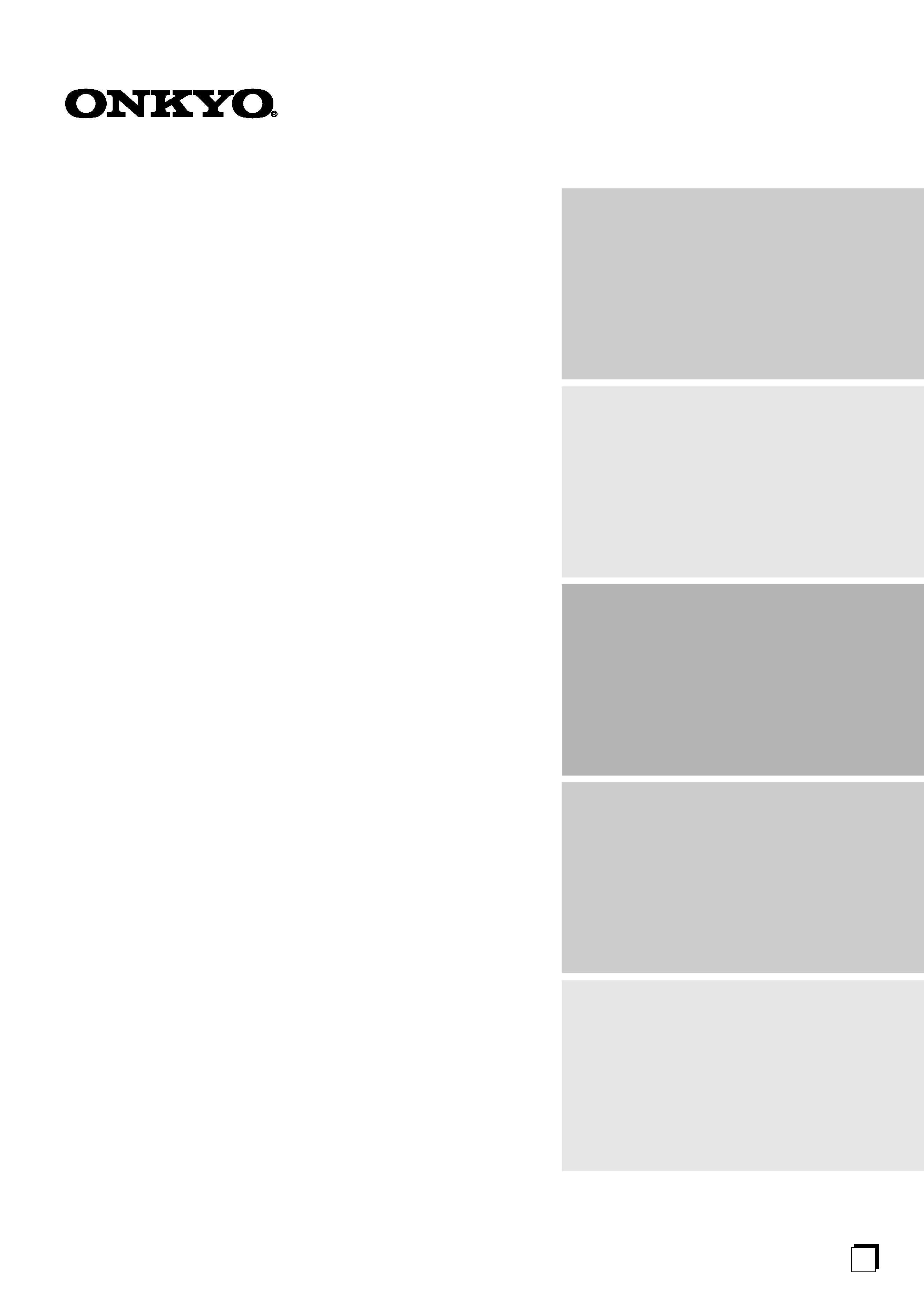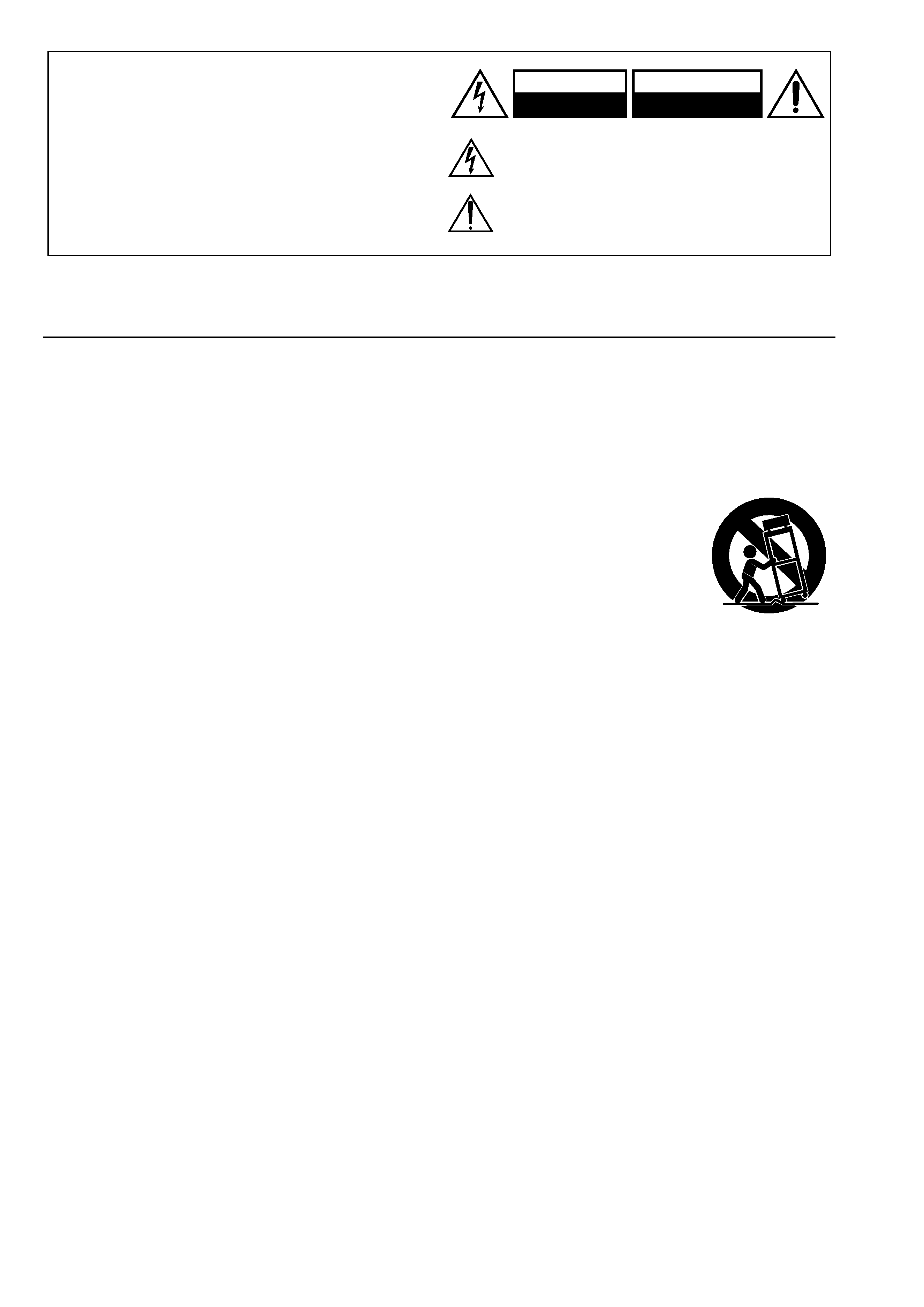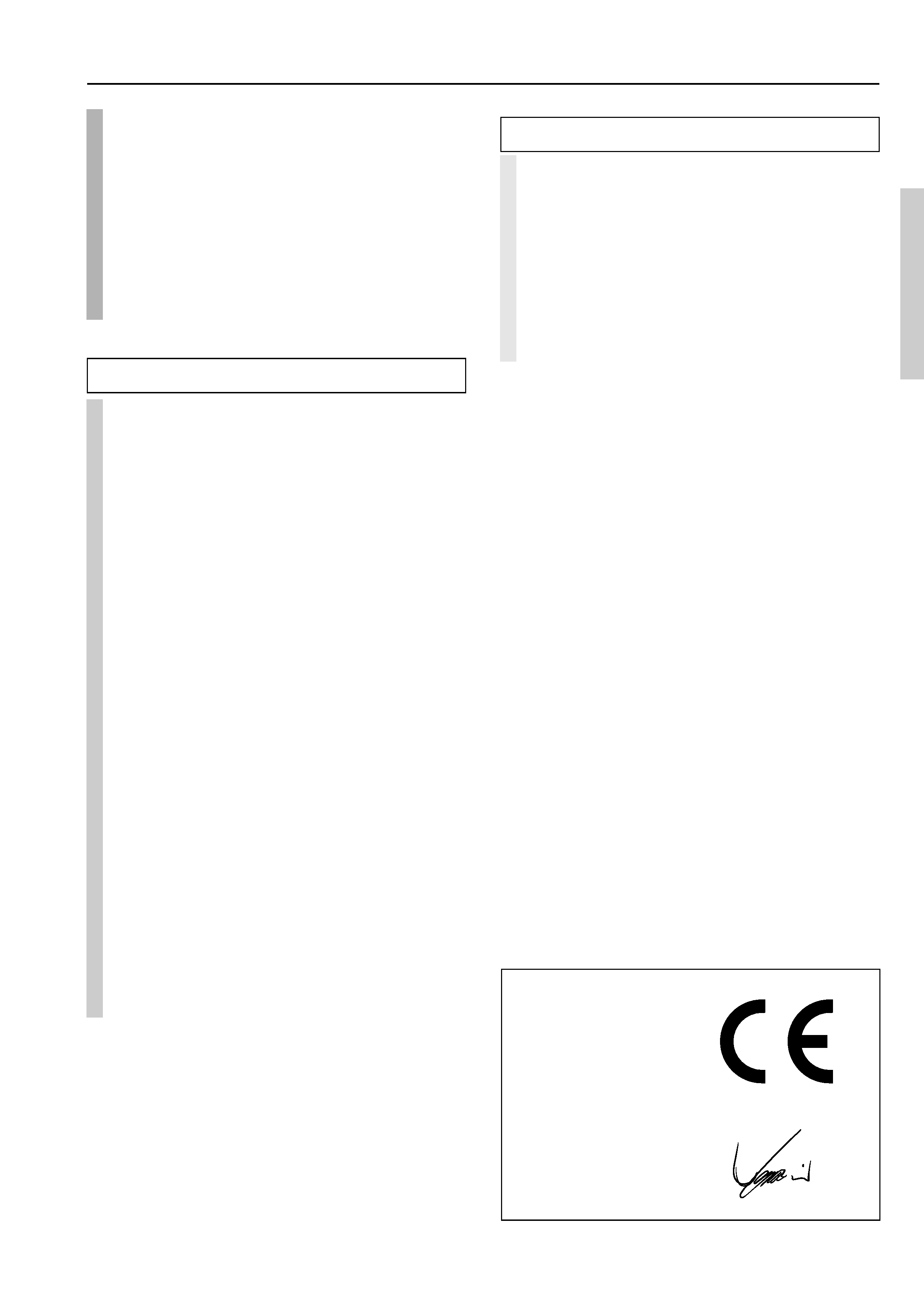
En
AV Receiver
TX-SR701/701E
TX-SR601/601E
Instruction Manual
Thank you for purchasing the Onkyo AV Receiver.
Please read this manual thoroughly before making
connections and plugging in the unit. Following the
instructions in this manual will enable you to obtain
optimum performance and listening enjoyment from
your new AV Receiver. Please retain this manual for
future reference.
Contents
Before using
2
Facilities and connections
8
Setup and operation
31
Remote controller
63
Appendix
75

2
Important Safety Instructions
1. Read Instructions All the safety and operating instructions
should be read before the appliance is operated.
2. Retain Instructions The safety and operating instructions
should be retained for future reference.
3. Heed Warnings All warnings on the appliance and in the
operating instructions should be adhered to.
4. Follow Instructions All operating and use instructions should
be followed.
5. Water and Moisture Do not use the appliance near water
for example, near a bath tub, wash bowl, kitchen sink, or
laundry tub; in a wet basement; or near a swimming pool; and
the like.
6. Cleaning Unplug the appliance from the wall outlet before
cleaning. The appliance should be cleaned with a dry cloth or
only as recommended by the manufacturer.
7. Ventilation Slots and openings in the cabinet are provided for
ventilation and to ensure reliable operation of the appliance and
to protect it from overheating, and these openings must not be
blocked or covered. Do not use the appliance on a bed, sofa,
rug, or other such surface. Newspapers, table clothes, curtains,
and other items can inadvertently block ventilation slots. Do not
place the unit near curtains that could obstruct the ventilation. If
you install the appliance in a built-in installation, such as a
bookcase or rack, ensure that there is adequate ventilation.
Leave 20 cm (8") of free space at the top and sides and 10 cm
(4") at the rear. The rear edge of the shelf or board above the
appliance should be set 10 cm (4") away from the rear panel or
wall, creating a flue-like gap for warm air to escape.
8. Heat The appliance should be situated away from heat
sources such as radiators, heat registers, stoves, or other
appliances (including amplifier) that produce heat.
9. Grounding or Polarization The appliance may be equipped
with a polarized alternating current line plug (a plug having one
blade wider than the other). This plug will fit into the power
outlet only one way. This is a safety feature. If you are unable to
insert the plug fully into the outlet, try reversing the plug. If the
plug should still fail to fit, contact your electrician to replace
your obsolete outlet. Do not defeat the safety purpose of the
polarized or grounding-type plug.
A grounding type plug has two blades and a third grounding
prong. The wide blade or the third prong are provided for your
safety. If the provided plug does not fit into your outlet, consult
an electrician for replacement of the obsolete outlet.
10. Power-Cord Protection Power-supply cords should be
routed so that they are not likely to be walked on or pinched by
items placed upon or against them, paying particular attention
to cords at plugs, convenience receptacles, and the point where
they exit from the appliance.
11. Attachments Do not use attachments not recommended by
the appliance manufacturer as they may cause hazards.
Accessories Do not place the appliance on an unstable cart,
stand, tripod, bracket, or table. The appliance may fall, causing
serious injury to a child or adult, and serious damage to the
appliance. Use only with a cart, stand, tripod, bracket, or table
recommended by the manufacturer, or sold with the appliance.
Any mounting of the appliance should
follow the manufacturer's instructions,
and should use a mounting accessory
recommended by the manufacturer.
12. An appliance and cart combination
should be moved with care to avoid
injury from tip-over.
Quick stops, excessive force, and uneven
surfaces may cause the appliance and
cart combination to overturn.
13. Lightning For added protection for the appliance during a
lightning storm, or when it is left unattended and unused for
long periods of time, unplug it from the wall outlet and
disconnect the antenna or cable system. This will prevent
damage to the appliance due to lightning and power-line surges.
14. Servicing Do not attempt to service the appliance yourself as
opening or removing covers may expose you to dangerous
voltage or other hazards. Refer all servicing to qualified service
personnel.
Damage Requiring Service Unplug the appliance form the
wall outlet and refer servicing to qualified service personnel
under the following conditions:
A. When the power-supply cord or plug is damaged,
B. If liquid has been spilled, or objects have fallen into the
appliance,
C. If the appliance has been exposed to rain or water,
D. If the appliance does not operate normally by following the
operating instructions. Adjust only those controls that are
covered by the operating instructions as an improper
adjustment of other controls may result in damage and will
often require extensive work by a qualified technician to
restore the appliance to its normal operation,
E. If the appliance has been dropped or damaged in any way,
and
F. When the appliance exhibits a distinct change in performance
this indicates a need for service.
15. Object and Liquid Entry Never push objects of any kind
into the appliance through openings as they may touch
dangerous voltage points or short-out parts that could result in a
fire or electric shock.
The appliance should not be exposed to dripping or splashing
and no objects filled with liquids, such as vases should be
placed on the appliance.
Don't put candles or other burning objects on top of this unit.
16. Batteries Always consider the environmental issues and
follow local regulations when disposing of batteries.
WARNING:
TO REDUCE THE RISK OF FIRE OR ELECTRIC SHOCK,
DO NOT EXPOSE THIS APPLIANCE TO RAIN OR
MOISTURE.
CAUTION:
TO REDUCE THE RISK OF ELECTRIC SHOCK, DO NOT
REMOVE COVER (OR BACK). NO USER-SERVICEABLE
PARTS INSIDE. REFER SERVICING TO QUALIFIED
SERVICE PERSONNEL.
The lightning flash with arrowhead symbol, within an equilateral
triangle, is intended to alert the user to the presence of uninsulated
"dangerous voltage" within the product's enclosure that may be of
sufficient magnitude to constitute a risk of electric shock to persons.
The exclamation point within an equilateral triangle is intended to
alert the user to the presence of important operating and maintenance
(servicing) instructions in the literature accompanying the appliance.
WARNING
RISK OF ELECTRIC SHOCK
DO NOT OPEN
RISQUE DE CHOC ELECTRIQUE
NE PAS
OUVRIR
AVIS
PORTABLE CART WARNING
S3125A

3
Precautions
1. Recording Copyright
Recording of copyrighted material for other than personal use is
illegal without permission of the copyright holder.
2. AC Fuse
The fuse is located inside the chassis and is not user-serviceable. If power
does not come on, contact your Onkyo authorized service station.
3. Care
From time to time you should wipe the front and rear panels and the
cabinet with a soft cloth. For heavier dirt, dampen a soft cloth in a
weak solution of mild detergent and water, wring it out dry, and
wipe off the dirt. Following this, dry immediately with a clean
cloth. Do not use rough material, thinners, alcohol or other
chemical solvents or cloths since these could damage the finish or
remove the panel lettering.
4. Power
WARNING
BEFORE PLUGGING IN THE UNIT FOR THE FIRST TIME,
READ THE FOLLOWING SECTION CAREFULLY.
The voltage of the available power supply differs according to
country or region. Be sure that the power supply voltage of the area
where this unit will be used meets the required voltage (e.g., AC
230 V, 50 Hz or AC 120 V, 60 Hz) written on the rear panel.
Worldwide models are equipped with a voltage selector to conform
to local power supplies. Be sure to set this switch to match the
voltage of the power supply in your area before plugging in the unit.
For British models
Replacement and mounting of an AC plug on the power supply cord
of this unit should be performed only by qualified service personnel.
IMPORTANT
The wires in the mains lead are colored in accordance with the
following code:
Blue
: Neutral
Brown : Live
As the colors of the wires in the mains lead of this apparatus may
not correspond with the colored markings identifying the terminals
in your plug, proceed as follows:
The wire which is colored blue must be connected to the terminal
which is marked with the letter N or colored black.
The wire which is colored brown must be connected to the terminal
which is marked with the letter L or colored red.
IMPORTANT
A 5 ampere fuse is fitted in this plug. Should the fuse need to be
replaced, please ensure that the replacement fuse has a rating of 5
amperes and that it is approved by ASTA or BSI to BS1362. Check
for the ASTA mark or the BSI mark on the body of the fuse.
IF THE FITTED MOULDED PLUG IS UNSUITABLE FOR THE
SOCKET OUTLET IN YOUR HOME THEN THE FUSE
SHOULD BE REMOVED AND THE PLUG CUT OFF AND
DISPOSED OF SAFELY. THERE IS A DANGER OF SEVERE
ELECTRICAL SHOCK IF THE CUT OFF PLUG IS INSERTED
INTO ANY 13 AMPERE SOCKET.
If in any doubt, consult a qualified electrician.
For U.S. models
Note to CATV system installer:
This reminder is provided to call the CATV system installer's
attention to Section 820-40 of the NEC which provides guidelines
for proper grounding and, in particular, specifies that the cable
ground shall be connected to the grounding system of the building,
as close to the point of cable entry as practical.
FCC INFORMATION FOR USER
CAUTION:
The user changes or modifications not expressly approved by the
party responsible for compliance could void the user's authority to
operate the equipment.
NOTE:
This equipment has been tested and found to comply with the limits
for a Class B digital device, pursuant to Part 15 of the FCC Rules.
These limits are designed to provide reasonable protection against
harmful interference in a residential installation. This equipment
generates, uses and can radiate radio frequency energy and, if not
installed and used in accordance with the instructions, may cause
harmful interference to radio communications. However, there is no
guarantee that interference will not occur in a particular installation.
If this equipment does cause harmful interference to radio or
television reception, which can be determined by turning the
equipment off and on, the user is encouraged to try to correct the
interference by one or more of the following measures:
· Reorient or relocate the receiving antenna.
· Increase the separation between the equipment and receiver.
· Connect the equipment into an outlet on a circuit different from
that to which the receiver is connected.
· Consult the dealer or an experienced radio/TV technician for
help.
For Canadian models
NOTE: THIS CLASS B DIGITAL APPARATUS COMPLIES
WITH CANADIAN ICES-003.
For models having a power cord with a polarized plug:
CAUTION: TO PREVENT ELECTRIC SHOCK, MATCH
WIDE BLADE OF PLUG TO WIDE SLOT, FULLY INSERT.
Modèle pour les Canadien
REMARQUE: CET APPAREIL NUMÉRIQUE DE LA
CLASSE B EST CON-FORME À LA NORME NMB-003 DU
CANADA.
Sur les modèles dont la fiche est polarisée:
ATTENTION: POUR ÉVITER LES CHOCS ÉLECTRIQUES,
INTRODUIRE LA LAME LA PLUS LARGE DE LA FICHE
DANS LA BORNE CORRESPONDANTE DE LA PRISE ET
POUSSER JUSQU'AU FOND.

4
Contents
Important Safety Instructions ........................... 2
Precautions ......................................................... 3
Contents .............................................................. 4
Features .............................................................. 6
Supplied accessories ........................................ 7
Before using this unit ........................................ 7
Setting the voltage selector (Worldwide models only) ...... 7
Installing the remote controller batteries .......................... 7
Using the remote controller .............................................. 7
Front panel facilities .......................................... 8
Front panel ...................................................................... 8
Front panel display ....................................................... 11
Remote controller ............................................ 12
Connections ..................................................... 14
TX-SR701/701E ............................................................ 15
TX-SR601/601E ............................................................ 15
Connecting your audio components ............................... 16
Connecting your video components ............................... 17
12V TRIGGER ZONE 2 terminal .................................. 21
PRE OUT (TX-SR701/701E only) ................................. 21
Operating components not reached by the
remote controller signals (IR IN) ................ 22
If the remote controller signal does not reach
the TX-SR701/701E/601/601E remote sensor ........ 22
Connecting the remote zone (Zone 2) speakers ...23
When using the ZONE 2 SPEAKERS terminals ............ 23
When using the ZONE 2 LINE OUT terminals ............. 23
When using the ZONE 2 PRE OUT terminals
(TX-SR701/701E only)............................................ 23
Connections ..................................................... 24
AC OUTLETS ................................................................ 24
REMOTE CONTROL .............................................. 24
Connecting speakers ....................................... 25
Standard speaker setup for surround sound .................... 25
Minimum speaker configuration for surround sound
playback .................................................................. 25
Speaker placement .......................................................... 25
Using the speaker cable labels ........................................ 26
Connecting a subwoofer ................................................. 26
Connecting the surround back speakers
(TX-SR701/701E only) ........................................... 26
Connecting speakers ....................................................... 27
Connecting the speaker cable ......................................... 27
Connecting the power .................................... 28
Connecting a subwoofer ................................................. 28
Turning on the power ...................................................... 28
Turning on the power from the remote controller .......... 28
Before using
Facilities and connections
Connecting antennas ....................................... 29
Assembling the AM loop antenna ...................................29
Connecting the AM antenna cable ..................................29
Connecting the included antennas ...................................29
Connecting an FM outdoor antenna ................................30
Connecting an AM outdoor antenna ................................30
Directional linkage ..........................................................30
Connecting the antenna cable to the 75/300
antenna
adapter (For all models other than USA & Canadian
models and European models) .................................30
Configuring the speakers ................................ 31
Displaying the Main Menu ..............................................31
Speaker Configuration .....................................................31
Setting the speaker distance from your normal listening
position ....................................................................33
Calibrating the speaker levels ..........................................34
Buttons used for navigating through the menus ..............36
Listening to Radio Broadcasts ....................... 37
Tuning into a radio station ...............................................37
Listening to a stereo radio station (FM mode) ................37
Presetting a radio station .................................................38
Selecting a preset radio station ........................................38
Erasing a preset radio station ..........................................38
Listening to RDS broadcasts
(European models only) ............................. 39
Listening to RDS broadcasts ...........................................39
PTY program types in Europe .........................................39
Displaying Radio Text (RT) ............................................40
Performing a PTY scan ...................................................40
Performing a TP scan ......................................................40
Selecting an Audio Component ...................... 41
Basic operation ................................................................41
Selecting the type of audio input signal ..........................42
Temporarily changing the speaker output levels .............43
To change the display of the input source
from TAPE to MD ...................................................43
Using the sleep time (remote controller only) .................44
Listening with headphones ..............................................44
Enjoying DVD multichannel audio playback ..................44
Switching the display ......................................................45
Temporarily turning off the sound ...................................45
Listening Modes ............................................... 46
Selecting a listening mode (TX-SR701/701E) ................48
Re-EQ function for movies (TX-SR701/701E only) ......49
Selecting a listening mode (TX-SR601/601E) ................50
Original filter (CinemaFILTER) loading for movies
(TX-SR601/601E only) ...........................................51
Input Setup ........................................................ 52
Hardware Setup ................................................ 55
Hardware Config .............................................................55
Setup and operation

5
Contents
Preference .........................................................56
Preference ........................................................................56
Audio Adjust ......................................................57
Enjoying music in the remote zone .................60
Using the buttons .............................................................60
Using the remote controller .............................................60
Adjusting the volume for the remote zone ......................60
Recording ..........................................................61
Recording the input source (REC OUT selector) ...........61
Recording both the audio and video ...............................62
Using remote controller ...................................63
Overview ........................................................................ 63
Calling up a preset radio station ......................................63
Controlling an Onkyo cassette tape deck ........................63
Controlling an Onkyo DVD player .................................64
Controlling an Onkyo CD player ....................................65
Controlling an Onkyo MD recorder ................................66
Entering a pre-programming code ..................67
Learning a pre-programming code ..................................67
Pre-programming codes ..................................................68
Operating your programmed
remote controller .........................................69
DVD MODE (DVD Player Mode) ..................................69
SAT MODE (Satellite Tuner Mode) ...............................69
CABLE MODE (Cable Mode) .......................................69
VCR MODE (VCR Mode) .............................................70
TV MODE (TV Mode) ...................................................70
Programming the commands of remote
controllers for other devices into the
remote controller .........................................71
Programming procedure ..................................................71
Erasing the programmed command from one button ......72
Erasing all the commands programmed under a MODE
button .......................................................................72
Using the macro function .................................73
What is the macro function? ........................................ 73
Programming the macro ..................................................73
Executing the macro ........................................................73
Erasing a macro from the MACRO 1 (or 2) button .........74
Erasing all commands and macros that have been
programmed .............................................................74
Remote controller
Troubleshooting guide ......................................75
POWER .......................................................................... 75
SPEAKERS .................................................................... 75
FM/AM TUNER ............................................................. 75
VIDEO and AUDIO ........................................................ 76
REMOTE CONTROLLER ............................................. 76
OTHER ........................................................................... 76
If one of the messages shown below appears ................. 77
Specifications (TX-SR701/701E) ......................78
Specifications (TX-SR601/601E) ......................79
Appendix
Declaration of Conformity
We, ONKYO EUROPE
ELECTRONICS GmbH
INDUSTRIESTRASSE 20
82110 GERMERING,
GERMANY
GERMERING, GERMANY
ONKYO EUROPE ELECTRONICS GmbH
I. MORI
declare in own responsibility, that the ONKYO product described
in this instruction manual is in compliance with the corresponding
technical standards such as EN60065, EN55013, EN55020 and
EN61000-3-2, -3-3.
